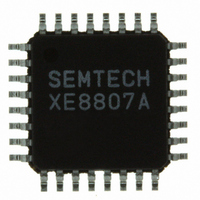XE8807AMI026TLF Semtech, XE8807AMI026TLF Datasheet - Page 4

XE8807AMI026TLF
Manufacturer Part Number
XE8807AMI026TLF
Description
IC MCU LOW PWR MTP FLASH 32-TQFP
Manufacturer
Semtech
Datasheet
1.XE8807AMI026TLF.pdf
(143 pages)
Specifications of XE8807AMI026TLF
Applications
Sensing Machine
Core Processor
RISC
Program Memory Type
FLASH (11 kB)
Controller Series
XE8000
Ram Size
512 x 8
Interface
UART, USRT
Number Of I /o
24
Voltage - Supply
2.4 V ~ 5.5 V
Operating Temperature
-40°C ~ 85°C
Mounting Type
Surface Mount
Package / Case
32-TQFP, 32-VQFP
For Use With
XE8000MP - PROG BOARD AND PROSTART2 CARD
Lead Free Status / RoHS Status
Lead free / RoHS Compliant
Other names
XE8807AMI026TR
Available stocks
Company
Part Number
Manufacturer
Quantity
Price
Company:
Part Number:
XE8807AMI026TLF
Manufacturer:
IDT
Quantity:
62
XE8806A/XE8807A
1.1 Top schematic
The top level block schematic of the circuit is shown in Figure 1-1. The heart of the circuit consists of the
Coolrisc816 CPU (central processing unit) core. This core includes an 8x8 multiplier and 16 internal registers.
The bus controller generates all control signals for access to all data registers other than the CPU internal
registers.
The reset block generates the adequate reset signals for the rest of the circuit as a function of the set-up contained
in its control registers. Possible reset sources are the power-on-reset (POR), the external pin NRESET, the
watchdog (WD), a bus error detected by the bus controller or a programmable pattern on Port A.
The clock generation and power management block sets up the clock signals and generates internal supplies for
different blocks. The clock can be generated from the RC oscillator (this is the start-up condition), the crystal
oscillator (XTAL) or an external clock source (given on the XIN pin).
The test controller generates all set-up signals for different test modes. In normal operation, it is used as a set of 8
low power RAM. If power consumption is important for the application, the variables that need to be accessed
frequently should be stored in these registers rather than in the RAM.
The IRQ handler routes the interrupt signals of the different peripherals to the IRQ inputs of the CPU core. It allows
masking of the interrupt sources and it flags which interrupt source is active.
Events are generally used to restart the processor after a HALT period without jumping to a specified address, i.e.
the program execution resumes with the instruction following the HALT instruction. The EVN handler routes the
event signals of the different peripherals to the EVN inputs of the CPU core. It allows masking of the event sources
and it flags which event source is active.
The Port B is an 8 bit parallel IO port with analog capabilities. The USRT, UART, PWM and CMPD blocks also
make use of this port.
The instruction memory is a 22-bit wide flash or ROM memory depending on the circuit version. In case of the
ROM version, the VPP pin is not used. The maximal number of instructions in the XE8806A is 8192. The maximal
number of instructions in the XE8807A is 4096.
The data memory on this product is a 512 byte SRAM.
The port A is an 8 bit parallel input port. It can also generate interrupts, events or a reset. It can be used to input
external clocks for the timer/counter/PWM block.
The Port D is a general purpose 8 bit parallel IO port.
The USRT (universal synchronous receiver/transmitter) contains some simple hardware functions in order to
simplify the software implementation of a synchronous serial link.
The UART (universal asynchronous receiver/transmitter) contains a full hardware implementation of the
asynchronous serial link.
The RFIF interface is a serial interface dedicated to communication with RF circuits. From the CPU side, it very
much looks like an ordinary UART but it also implements low level coding/decoding and frame synchronisation.
The input/output pins are multiplexed on port D.
The counters/timers/PWM can take its clocks from internal or external sources (on Port A) and can generate
interrupts or events. The PWM is output on Port B.
The VLD (voltage level detector) detects the battery end of life with respect to a programmable threshold.
The CMPD contains a 4 channel comparator. It is intended to monitor analog or digital signals whilst having a very
low power consumption.
© Semtech 2006
www.semtech.com
1-2













